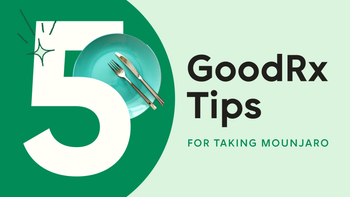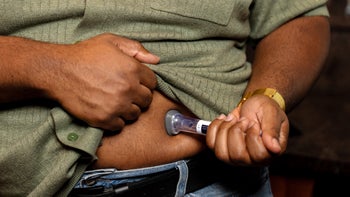
How Much Is Mounjaro With and Without Insurance?
Key takeaways:
Mounjaro (tirzepatide) is a prescription medication that’s FDA-approved to treat Type 2 diabetes. Without insurance, the average monthly cost of Mounjaro is between $1,000 and $1,200, depending on the pharmacy.
Although your medical team may prescribe you Mounjaro off-label for weight loss, your insurance company may only cover Mounjaro for Type 2 diabetes, since that’s what it is FDA-approved for.
Zepbound (tirzepatide), another medication manufactured by Eli Lilly that contains the same active ingredient as Mounjaro, was FDA-approved for chronic weight management in 2023.
If you have commercial insurance, you could pay as little as $25 for a 1-, 2-, or 3-month supply of Mounjaro or Zepbound.
Table of contents

Mounjaro (tirzepatide) is an injectable, prescription-only medication that’s used along with diet and exercise to improve blood sugar control in adults.
It was approved by the FDA to treat Type 2 diabetes in May 2022. But since then, Mounjaro has gained attention for its effectiveness as a weight-loss medication. In studies released by Eli Lilly, Mounjaro’s manufacturer, taking tirzepatide led to superior weight-loss results compared with taking a placebo (an injection without medication in it).
If you’re considering taking Mounjaro and have insurance, find out if the medication is covered by your plan for your specific needs. Mounjaro can cost around $12,000 or more per year if you’re paying entirely out of pocket.
Get Lantus For Less
With GoodRx, pay no more than $35 for a 30 day supply of Lantus.

GoodRx is NOT insurance. GoodRx Health information and resources are reviewed by our editorial staff with medical and healthcare policy and pricing experience. See our editorial policy for more detail. We also provide access to services offered by GoodRx and our partners when we think these services might be useful to our visitors. We may receive compensation when a user decides to leverage these services, but making them available does not influence the medical content our editorial staff provides.
How much does Mounjaro cost, and what affects the price?
The list price for Mounjaro is approximately $1,080 per fill. A fill contains four prefilled pens, which is equal to about a month's supply of Mounjaro. That means Mounjaro costs over $12,900 annually, at the list price. The list price for Zepbound is about $1,086 for a 28-day supply.
If you have insurance, you typically won’t pay the list price for Mounjaro. The cost you’ll pay will depend on your insurance plan coverage, copays, and deductibles. And individuals with commercial insurance may pay as little as $25 for a 1-, 2-, or 3-month supply with a Mounjaro Savings Card.
Without insurance, the average retail price per fill ranges from $1,000 to $1,200 or more, depending on the pharmacy. The cost of Mounjaro can be affected by many factors, including:
Location: The average prices of prescription medications vary from city to city. According to GoodRx research, prescription medications typically cost more in New Orleans and Los Angeles than in Denver, for example.
Pharmacy: The price of Mounjaro varies from pharmacy to pharmacy — even among locations on the same block. Use GoodRx to compare prices and get the best deal in your area.
Reason for prescription: If your medical team prescribed you Mounjaro for Type 2 diabetes, your insurance may cover some of the costs. But if you’re prescribed the medication off-label for weight loss, you may have to pay out of pocket. You could ask your insurer whether it covers Zepbound for your needs. If it does, you may want to ask your healthcare professional to prescribe you Zepbound instead of Mounjaro.
Prescription medication discounts: You could save money on Mounjaro with the help of a prescription discount platform such as GoodRx. To get started, go to https://www.goodrx.com, search for Mounjaro, and find the lowest price in your area.
Since there’s no generic version of Mounjaro and the medication is intended for long-term use, the costs can add up over time.
Does insurance cover Mounjaro?
Yes. If you have insurance, you may have coverage for Mounjaro. But it depends on your health plan’s formulary (its list of covered medications) and requirements. For example, your insurance company may cover Mounjaro for Type 2 diabetes, its FDA-approved use.
However, since Mounjaro is currently not approved by the FDA for weight loss, your insurance most likely won’t cover it for this purpose, even if you’re prescribed the medication “off-label.” Instead, your insurance may cover Zepbound (tirzepatide), another medication that is also manufactured by Eli Lilly. The FDA approved Zepbound for chronic weight management in November 2023, and it contains the same active ingredient as Mounjaro. Check your insurer’s formulary for details.
Does Medicare cover Mounjaro?
It depends. If you take Mounjaro to treat Type 2 diabetes, Medicare may provide coverage with an accepted prior authorization or step therapy, but it’s not guaranteed. Check the details of your Part D prescription medication plan to learn more.
At this time, Medicare isn’t allowed to cover weight-loss medications due to the 2003 Medicare Modernization Act (MMA). This act established Medicare Part D prescription medication benefits. Lawmakers at the time determined that weight-loss medications, such as Zepbound, were lifestyle medications, as opposed to medically necessary medications. So the MMA prohibits Part D plans from covering them solely for that purpose.
Does Medicaid cover Mounjaro?
It depends. Medicaid coverage varies by state, so you’ll have to contact your state or territory’s Medicaid agency to determine whether Mounjaro is covered.
Will your insurance cover weight-loss medications? Coverage for weight-loss medications varies by plan, but here’s what you should know about cost and coverage.
Got Medicare? Medicare, by law, is prohibited from covering weight-loss medications unless you meet these requirements.
Do you have Medicaid? Medicaid may cover some medications taken for weight loss, depending on your state’s program.
Generally, you have to meet certain income and household requirements to qualify for Medicaid. Medicaid enrollees currently have coverage for outpatient prescription medications in all states, although this is an optional benefit under federal law. However, each state has its own requirements and rules around things such as step therapy and prior authorizations. For example, Mounjaro is listed as nonpreferred on various state Medicaid formularies, including:
How to get insurance to cover Mounjaro
Even if your insurance plan covers Mounjaro for Type 2 diabetes, you may still need to prove you have the condition to get your medication covered. Below are four steps you can take to increase the chances of getting Mounjaro covered by your insurance.
Talk to your medical team. Schedule an appointment with your healthcare professional to discuss your medical needs, the potential benefits of Mounjaro, and the possibility of getting a prescription. It’s important that your healthcare professional documents these conversations and your treatment journey.
Review your insurance plan’s formulary. Check your plan’s formulary to understand your prescription medication coverage. If Mounjaro is not listed as a covered medication, you can ask your plan to consider covering it through its “exceptions process.” While this process varies from one insurance company to another, you’ll typically need to confirm that the medication is medically necessary and that other medications are not as effective.
Obtain a prior authorization if required. If your insurance company requires a prior authorization for Mounjaro, your healthcare professional may need to provide confirmation that you have Type 2 diabetes, along with information about your treatment and medical history. They must provide the best diagnosis code for your condition to avoid delays in getting your medication approved.
Request an appeal if necessary. If your insurance provider denies your initial request for coverage, you may appeal your denial. This allows you to submit supporting documentation, such as an appeal letter or letter of medical necessity, that can lead to your insurance company reconsidering its decision. Review your insurer’s appeals process, or call the company directly to discuss your options.
How much can you save with a Mounjaro Savings Card?
If you have commercial insurance, you may be able to pay as little as $25 for a 1-, 2-, or 3-month supply of Mounjaro with the help of a savings card. The requirements for the Mounjaro Savings Card are subject to change at any time, so it’s important to review the current savings and qualifications before purchasing the medication.
If you qualify for the Mounjaro Savings Card with your insurance, below are the maximum savings you can get for the medication. The card expires on December 31, 2025.
Mounjaro Savings Card benefits
Type of supply | Maximum savings |
|---|---|
1-month supply | $150 per prescription |
2-month supply | $300 per prescription |
3-month supply | $450 per prescription |
The Mounjaro Savings Card has a separate maximum savings limit of up to $1,950 per calendar year.
How to qualify for a Mounjaro Savings Card
If you have commercial medication insurance that covers Mounjaro, you must meet the following criteria to qualify for a Mounjaro Savings Card:
Prescription: You must have a prescription from your healthcare professional for Mounjaro for an FDA-approved use.
Insurance coverage: You cannot be enrolled in any government-funded healthcare programs, such as Medicaid or Medicare (including Part D and Advantage plans).
Residency: You must be a resident of the U.S. or Puerto Rico.
Age: You must be over 17 years of age.
If you have commercial medication insurance that doesn’t cover Mounjaro, you may still qualify for savings of up to $463 off a 1-month prescription fill of the medication. You must have a valid prescription for an FDA-approved use and provide HIPAA authorization to participate. The card can be used for up to 13 fills per calendar year, with a maximum annual savings of $6,019. Savings end on December 31, 2025, and program terms may change at any time.
Can you get Mounjaro for free?
Depending on your insurance plan, you may not have to pay any out-of-pocket expenses for Mounjaro if it’s prescribed for Type 2 diabetes. But since Mounjaro is usually listed as a "nonpreferred medication," it’s more likely that you’ll have a copay.
If you want to try Mounjaro before purchasing the medication, you can ask your healthcare professional if they have free samples available.
Frequently asked questions
No. There isn’t a generic version of Mounjaro available right now. That means you might have to pay the full price unless your insurance helps cover it. You can also check GoodRx for a coupon to help you save on your prescription.
If your insurance doesn’t cover Mounjaro or you’re not able to fill your prescription for another reason, ask your healthcare professional if you can try an alternative medication, such as Ozempic (semaglutide), Trulicity (dulaglutide), or Victoza (liraglutide). These are all FDA-approved to treat Type 2 diabetes. You might also be able to save money with a savings card for Ozempic or Trulicity if you qualify.
The bottom line
Without insurance, Mounjaro (tirzepatide) costs between $1,000 and $1,200 or more per fill on average. But most insurance plans cover the medication when it’s prescribed to treat Type 2 diabetes.
Since Mounjaro isn’t FDA-approved as a weight-loss treatment, you’ll most likely have to pay out of pocket if you want to use the medication for that purpose. If you have commercial insurance, you may qualify to pay as little as $25 with the Mounjaro Savings Card. You also can try asking your medical team about Zepbound, which is FDA-approved for chronic weight management, as an alternative.
Why trust our experts?


References
Delaware Medical Assistance Program. (2025). 2025 Delaware Medicaid preferred drug list (PDL). Delaware Health and Social Services Division of Medicaid & Medical Assistance.
Eli Lilly and Company. (2023). Tirzepatide demonstrated significant and superior weight loss compared to placebo in two pivotal studies.
Eli Lilly and Company. (2025). How much should I expect to pay for Mounjaro (tirzepatide)?
Eli Lilly and Company. (2025). How much should I expect to pay for Zepbound (tirzepatide)?
Illinois Department of Healthcare and Family Services. (2025). Illinois Medicaid preferred drug list.
Medicaid.gov. (n.d.). Eligibility policy.
Medicaid.gov. (n.d.). Prescription drugs.
North Carolina Division of Health Benefits. (2024). North Carolina Medicaid preferred drug list (PDL).
NYRx, the New York Medicaid Pharmacy Program. (2025). NYRx, the New York Medicaid Pharmacy Program.
Wreschnig, L. A. (2023). Medicare Part D prescription drug benefit. Congress.gov.
Wyoming Medicaid. (2024). Preferred drug list (PDL) February 7, 2024.
Was this page helpful?
Related Articles
Browse medications
View AllResearch prescriptions and over-the-counter medications from A to Z, compare drug prices, and start saving.




























